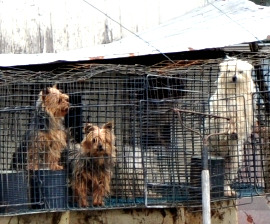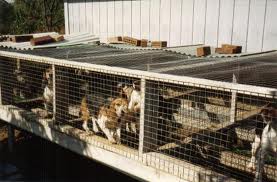Buying a puppy online
&
What is a Puppy Mill
Buying a puppy online is usually just as bad as buying one in a
pet store. Online puppy sale sites advertise the offspring of “champions”and use
a host of fancy terms—certified kennel, AKC registered, pedigree, health
certified—and picturesque photos of tail-wagging terriers, doe-eyed Chihuahuas
and every other adorable breed… but most of these dogs are puppy mill dogs. When
you support these sites, you’re supporting the puppy mill industry.
Don’t be fooled.
An informal online survey conducted by the
ASPCA reveals that just as many Americans are now purchasing their dogs over the
Internet as buying from pet stores. According to the Internet Crime Complaint
Center, hundreds of complaints are filed every year from victims who were
scammed when buying a dog online. While there are some reputable breeders
online, they are far and few between, and none of them will ship a puppy to you
without meeting you first. Even though they may advertise online, responsible
breeders will not make the transaction online. Here are some of the most common
scam scenarios puppy mill breeders’use on
consumers:
The Bait and Switch
In this classic scam, the
website depicts dozens of photos of cute and cuddly, happy and healthy puppies.
What the consumer doesn’t realize is that these are stock photos taken from a
clip-art file—or simply stolen from other websites. In this scam, virtually all
contact is done via email, and the puppy is typically shipped without the buyer
ever seeing the dog in person. The scam is revealed when the dog is delivered
and the buyer is faced not with the adorable puppy from the photos, but a sickly
dog, often of a different color or with different markings. Scammers count on
people feeling guilty or compassionate and choosing not to send the puppy
back.
Sanctuaries or Scamtuaries?
Unfortunately,
this next scam preys on animal lovers who want to help dogs in need. In this
scenario, the puppy mill will actually set up its website as a“rescue group” or
“sanctuary,” offering purebred puppies that have been rescued from shelters, bad
breeders, even from puppy mills! The scam is revealed by the price tag—the
“adoption fees” for these dogs often exceed $1,000! Breed rescue groups usually
charge no more than a few hundred dollars—because their goal is not to make
money, but to find wonderful homes for their
rescues.
AKC-Registered
AKC registry is a service
provided by the American Kennel Club. While many people believe AKC registration
means their puppies came from reputable breeders, being AKC-registered means
nothing more than your puppy’s parents both had AKC papers. While there are some
AKC regulations, they do not restrict puppy mills from producing AKC-registered
dogs. The fact is, many AKC-registered dogs are born in puppy
mills.
Never buy a dog you haven’t met in person. Make adoption your first option or choose a responsible
breeder.
Puppy mill puppies are typically sold to pet shops—usually through a
broker, or middleman—and marketed as young as eight weeks of age. The lineage
records of puppy mill dogs are often falsified.
What Is a Puppy Mill?
A puppy mill is a large-scale commercial dog breeding operation where profit
is given priority over the well-being of the dogs. Unlike responsible breeders,
who place the utmost importance on producing the healthiest puppies possible,
breeding at puppy mills is performed without consideration of genetic quality.
This results in generations of dogs with unchecked hereditary defects.
Puppy mill puppies are typically sold to pet shops—usually through a broker,
or middleman—and marketed as young as eight weeks of age. The lineage records of
puppy mill dogs are often falsified.
What Problems Are Common to Puppy Mill Dogs?
Illness, disease, fearful behavior and lack of socialization with humans and
other animals are common characteristics of dogs from puppy mills. Because puppy
mill operators fail to apply proper husbandry practices that would remove sick
dogs from their breeding pools, puppies from puppy mills are prone to congenital
and hereditary conditions.
These can include:
Epilepsy
Heart disease
Kidney disease
Musculoskeletal disorders (hip dysplasia, luxating patellas, etc.)
Endocrine disorders (diabetes, hyperthyroidism)
Blood disorders (anemia, Von Willebrand disease)
Deafness
Eye problems (cataracts, glaucoma, progressive retinal atrophy, etc.)
Respiratory disorders
On top of that, puppies often arrive in pet stores—and their new homes—with
diseases or infirmities.
These can include:
Giardia
Parvovirus
Distemper
Upper respiratory infections
Kennel cough
Pneumonia
Mange
Fleas
Ticks
Intestinal parasites
Heartworm
Chronic diarrhea
How Are Animals Treated at Puppy Mills?
Puppy mills usually house dogs in overcrowded and unsanitary conditions,
without adequate veterinary care, food, water and socialization. Puppy mill dogs
do not get to experience treats, toys, exercise or basic grooming. To minimize
waste cleanup, dogs are often kept in cages with wire flooring that injures
their paws and legs—and it is not unusual for cages to be stacked up in columns.
Breeder dogs at mills might spend their entire lives outdoors, exposed to the
elements—or crammed inside filthy structures where they never get the chance to
feel the sun or a gust of fresh air on their faces.
How Often Are Dogs Bred in Puppy Mills?
In order to maximize profits, female dogs are bred at every opportunity with
little to no recovery time between litters. When, after a few years, they are
physically depleted to the point that they no longer can reproduce, breeding
females are often killed. The mom and dad of the puppy in the pet store window
are unlikely to make it out of the mill alive—and neither will the many puppies
born with overt physical problems that make them unsalable to pet stores.
When and Why Did Puppy Mills Begin?
Puppy mills began sprouting up after World War II. In response to widespread
crop failures in the Midwest, the United States Department of Agriculture began
promoting purebred puppies as a fool-proof “cash” crop. It is easy to see why
this might have appealed to farmers facing hard times—breeding dogs does not
require the intense physical labor that it takes to produce edible crops, nor
are dogs as vulnerable to unfavorable weather. Chicken coops and rabbit hutches
were repurposed for dogs, and the retail pet industry—pet stores large and
small—boomed with the increasing supply of puppies from the new "mills." Today,
Missouri is considered the largest puppy mill state in the country.
Seeking a puppy supply source on the East Coast, puppy brokers—the middlemen
who deliver the dogs from mills to pet stores—convinced many of Pennsylvania’s
Amish farmers in the 1970s that puppies were the cash crop of the future.
Brokers conducted seminars to teach farmers how to operate their own breeding
facilities. Thirty years later, Lancaster County, PA, has the highest
concentration of puppy mills of any county in the nation and has earned the
dubious nickname of “Puppy Mill Capital of the East.”
How Can I Help Fight Puppy Mills?
There are many ways you can fight puppy mills, starting with refusing to
patronize the stores and websites that sell their dogs.
Do not buy a puppy from a pet store—in fact, do not buy a puppy from any place that does not allow you to see its entire facility and meet the mother dog. This includes websites that sell pets online. Anyone can put up a great-looking website boasting the highest standards of breeding and care, but you really have no way of knowing if such businesses are what they claim. Truly responsible breeders want to meet you before selling you one of their prized pups to be sure that he or she is going to a good home.
A puppy mill is a large-scale commercial dog breeding operation where profit
is given priority over the well-being of the dogs. Unlike responsible breeders,
who place the utmost importance on producing the healthiest puppies possible,
breeding at puppy mills is performed without consideration of genetic quality.
This results in generations of dogs with unchecked hereditary defects.
Puppy mill puppies are typically sold to pet shops—usually through a broker,
or middleman—and marketed as young as eight weeks of age. The lineage records of
puppy mill dogs are often falsified.
What Problems Are Common to Puppy Mill Dogs?
Illness, disease, fearful behavior and lack of socialization with humans and
other animals are common characteristics of dogs from puppy mills. Because puppy
mill operators fail to apply proper husbandry practices that would remove sick
dogs from their breeding pools, puppies from puppy mills are prone to congenital
and hereditary conditions.
These can include:
Epilepsy
Heart disease
Kidney disease
Musculoskeletal disorders (hip dysplasia, luxating patellas, etc.)
Endocrine disorders (diabetes, hyperthyroidism)
Blood disorders (anemia, Von Willebrand disease)
Deafness
Eye problems (cataracts, glaucoma, progressive retinal atrophy, etc.)
Respiratory disorders
On top of that, puppies often arrive in pet stores—and their new homes—with
diseases or infirmities.
These can include:
Giardia
Parvovirus
Distemper
Upper respiratory infections
Kennel cough
Pneumonia
Mange
Fleas
Ticks
Intestinal parasites
Heartworm
Chronic diarrhea
How Are Animals Treated at Puppy Mills?
Puppy mills usually house dogs in overcrowded and unsanitary conditions,
without adequate veterinary care, food, water and socialization. Puppy mill dogs
do not get to experience treats, toys, exercise or basic grooming. To minimize
waste cleanup, dogs are often kept in cages with wire flooring that injures
their paws and legs—and it is not unusual for cages to be stacked up in columns.
Breeder dogs at mills might spend their entire lives outdoors, exposed to the
elements—or crammed inside filthy structures where they never get the chance to
feel the sun or a gust of fresh air on their faces.
How Often Are Dogs Bred in Puppy Mills?
In order to maximize profits, female dogs are bred at every opportunity with
little to no recovery time between litters. When, after a few years, they are
physically depleted to the point that they no longer can reproduce, breeding
females are often killed. The mom and dad of the puppy in the pet store window
are unlikely to make it out of the mill alive—and neither will the many puppies
born with overt physical problems that make them unsalable to pet stores.
When and Why Did Puppy Mills Begin?
Puppy mills began sprouting up after World War II. In response to widespread
crop failures in the Midwest, the United States Department of Agriculture began
promoting purebred puppies as a fool-proof “cash” crop. It is easy to see why
this might have appealed to farmers facing hard times—breeding dogs does not
require the intense physical labor that it takes to produce edible crops, nor
are dogs as vulnerable to unfavorable weather. Chicken coops and rabbit hutches
were repurposed for dogs, and the retail pet industry—pet stores large and
small—boomed with the increasing supply of puppies from the new "mills." Today,
Missouri is considered the largest puppy mill state in the country.
Seeking a puppy supply source on the East Coast, puppy brokers—the middlemen
who deliver the dogs from mills to pet stores—convinced many of Pennsylvania’s
Amish farmers in the 1970s that puppies were the cash crop of the future.
Brokers conducted seminars to teach farmers how to operate their own breeding
facilities. Thirty years later, Lancaster County, PA, has the highest
concentration of puppy mills of any county in the nation and has earned the
dubious nickname of “Puppy Mill Capital of the East.”
How Can I Help Fight Puppy Mills?
There are many ways you can fight puppy mills, starting with refusing to
patronize the stores and websites that sell their dogs.
Do not buy a puppy from a pet store—in fact, do not buy a puppy from any place that does not allow you to see its entire facility and meet the mother dog. This includes websites that sell pets online. Anyone can put up a great-looking website boasting the highest standards of breeding and care, but you really have no way of knowing if such businesses are what they claim. Truly responsible breeders want to meet you before selling you one of their prized pups to be sure that he or she is going to a good home.



